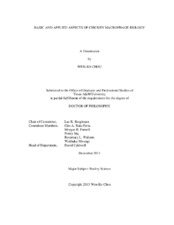| dc.description.abstract | The best way to prevent infectious disease is to directly establish mucosal immunity and also induce circulatory immunity to avoid pathogen invasion and spread. In our first study, we tested the hypothesis that a single mucosal or subcutaneous administration of antigen immunotargeted to chicken CD40 can effectively target antigen-presenting cells (APCs) of the mucosal associated lymphoid tissue (MALT) and induce specific mucosal sIgA and circulatory IgG. Levels of peptide-specific tracheal mucosa sIgA and circulatory IgG were measured on day 7 and 14 post-injection (p.i.) by ELISA. The results indicated that a single subcutaneous (s.c.) injection of anti-chCD40 guided 2C5-peptide complex not only induced a rapid and strong systemic peptide-specific IgG immune response, but also established a significant mucosal sIgA immune response.
Currently, only a few APC-specific markers and monoclonal antibodies (Mabs) are available in chicken. In mice, peritoneal exudate macrophages (PEMs) have been demonstrated to express the M1 phenotype and display CD62L on their cell surface, which allows them to migrate to lymph nodes as functional APCs. This makes chicken inflammatory-type PEMs a potential target for generating Mabs. However, the functional phenotype of chicken PEMs has yet to be elucidated. In the second and third study, we defined the functional phenotypes of two chicken macrophage models (Sephadex- and egg yolk-PEMs, S- and Y-PEMs) and generated Mabs against S-PEMs. The results suggest that arginase activity, the gene expression of the SOCS1/STAT3 axis, and the SOCS1/SOCS3 ∆Ct ratio, cannot be used as markers for phenotyping in chickens as in mice. Our results demonstrate that S-PEMs skew the phenotype to the M1 side and Y-PEMs shift the phenotype towards M2. In the final study, three new Mabs against S-PEMs were generated. Two candidate antigens, CD110 and Fat 1, were recognized by 3F6 Mab using a 7-mer peptide phage display library. In mice, the expression of CXCR4 mRNA (a homing receptor) was shown to be up-regulated in the presence of thrombopoietin-CD110 ligation, which suggests that S-PEMs may have the potential to migrate to peripheral lymphoid tissues to function as APCs in the chicken.
The poultry industry needs a new generation of vaccines to induce both mucosal and systemic immunity in a single immunization. The antibody-guided CD40-targeting concept described in this dissertation provides a new platform that can fit this need. | en |


